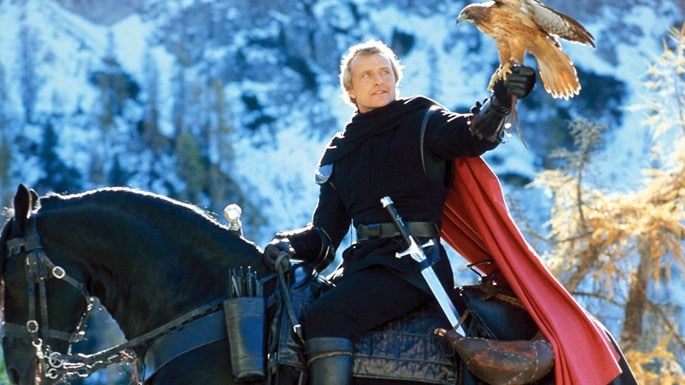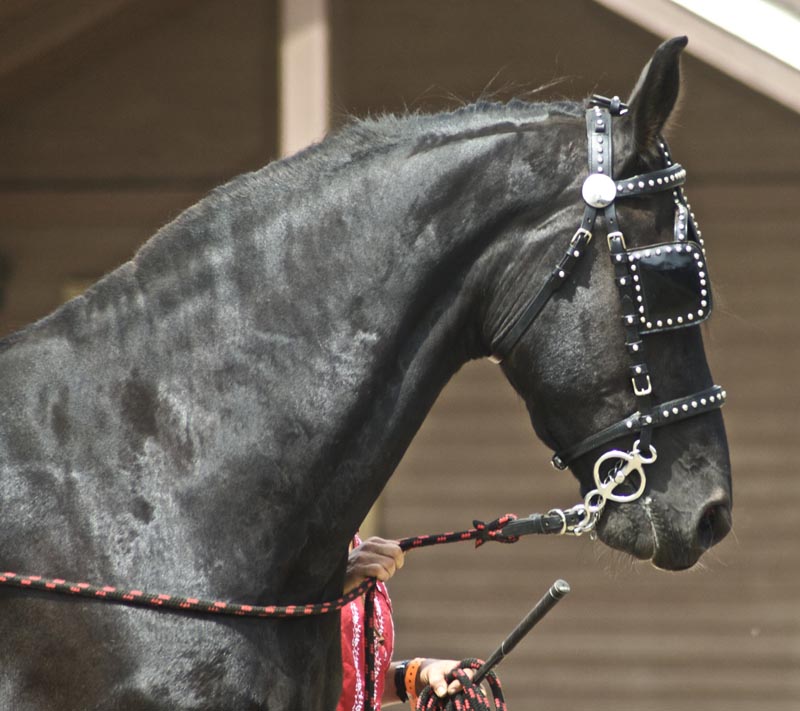The Friesian horse breed is one of the most iconic in the world. These black horses are popular in everything from movies to Internet posts. But there is more to the Friesian than beauty.
Breed Stats
Height 14.2 – 17 hh
Color black. Occasionally, chestnut, as the gene is recessive and the black may mask its presence.
Conformation long, arched neck, a “Spanish nose”, muscular bodies with sloping shoulders, short but strong limbs. They have feathering on their legs and thick mane and tail. There are two types of Friesian, one heavier (Baroque) and one lighter, more adapted to sports (“sports type”).
Uses their main use is driving and under saddle, especially in dressage. A type of carriage, the Sjee, exists specifically for the Friesian. Because of their striking appearance and calm demeanor, they are popular in filmmaking, in special for historic and fantasy films.
The Friesian Horse Breed
Most of us know what a Friesian looks like, though we may not know the name. The Friesian horse breed is very present in fantasy and medieval-set movies. This is because of its size and beauty, its gentle nature and flashy motion.
But while we found it beautiful in Ladyhawke and the beautiful photos in your social media stream, few know this breed almost went extinct.

A Friesian horse, Othello, plays the role of Goliath in the movie Ladyhawke.
The Friesian horse breed comes from the Friesland region in the northern Netherlands, from which it gets its name. This horse breed is native to the region, where it served many functions, but in special as a draft horse.
The association with fantasy and medieval settings isn’
t entirely incorrect, though: the Friesian stock was useful to knights. When weaponry and armour became lighter around the 12th century, knights sought out Friesian horses as mounts.
Bred with Eastern horses and, later, Andalusians, became a popular choice for knights to go to war. The warhorses of old were much smaller than current-day Friesians, though: their height was around 15hh.
The Friesian was a good warhorse due to its smooth trot and spirit: neither too hot nor too cold. This makes the Friesian a warmblood, rather than a draft (or coldblood) horse breed. As the Andalusian, these horses kept the “medieval warhorse” look. This makes them also one of the Baroque type horse breeds.

The Friesian is popular for driving, both recreational and competitive.
In the 18th and 19th centuries, well after the medieval times, the breed became popular as a harness horse, in part due to its flashy appearance.
The first society concerning Friesian horses appeared around 1879. From this studbook society (Fries Rundvee Stamboek — FRS) came the first studbook in 1880 (Paardenstamboek).
The breed was not without issue: cross-breeding with other horses from the region led to a dwindling of purebred Friesians. The situation became so dire that in the early 20th century, there were only three available breeding stallions left.
This cross-breeding happened due to the popularity of other breeds, such as the Ostfriesen and Alt-Oldenburger. The FRS also registered stallions from that breed, which complicated matters. Eventually, the society (renamed Friesch Paarden Stamboek — FPS — in 1906) unified the registries, but it would only become exclusive to the Friesian horse breed in 1943.
Mechanization made the Friesian less useful in farm work. But unlike other breeds, World War II gave it the time necessary for the Friesian horse’s population to grow once again.
Due to the war effort, the horses became relevant again. Together with the war, the Strassburger Circus also helped to keep the breed alive. At one point, the circus had twelve Friesian stallions in its roster, among other animals.
Unfortunately, its relatively small numbers created a lot of inbreeding. The breed today suffers from genetic issues such as dwarfism, megaesophagus and hydrocephaly, among other issues. These issues affect a disproportionate number of Friesian horses, due to the close bloodlines necessary to keep the breed alive.
Still, in spite of its issues, the Friesian horse breed does make for beautiful, striking and gentle animals. We will certainly see more of in movie screens, TV shows and show rings for a very long time.
Source: horseyhooves.com





